AMD Radeon HD 7970 GHz Edition 3 GB Graphics Card Review

How does the supercharged Radeon HD 7970 differ from the regular one and how does it compare to the predecessors and Nvidia competitors? Our today’s review will answer these and many other related questions you might have.
The AMD Radeon HD 7970 GHz Edition has been eagerly expected because rumors of the accelerated version started to circulate right after the regular Radeon HD 7970 was announced and its Tahiti GPU was found to have high overclocking potential. The delay with the introduction of the GHz Edition, which came out after its main opponent Nvidia GeForce GTX 680, must have been due not only to some manufacturing issues with the new 28nm tech process but also to AMD’s desire to time it to a price cut for the entire graphics card series. The Radeon HD 7970 GHz Edition costs $499, which is $50 cheaper than the recommended price of the Radeon HD 7970 when the latter came out half a year ago. The regular HD 7970, in its turn, is priced at $429 now.
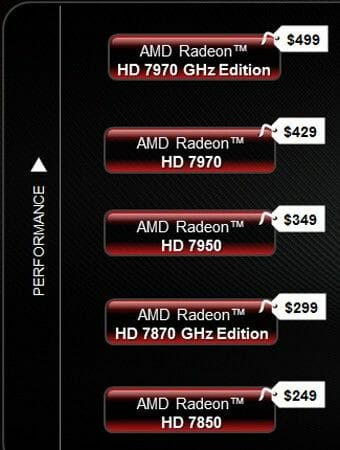
In this review we want to take a closer look at the new graphics card and see if it can claim to be the fastest single-GPU solution available now.
Technical Specifications
We summed up all the technical specifications of the AMD Radeon HD 7970 GHz Edition in the table below. For the convenience of comparison we are putting them side by side with the specs of AMD Radeon HD 7970 and NVIDIA GeForce GTX 680:
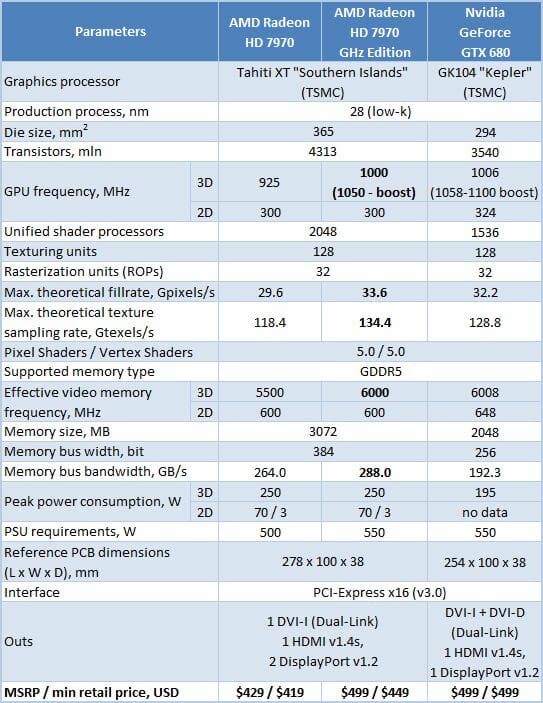
Design and Functionality
The reference Radeon HD 7970 GHz Edition looks absolutely identical to the regular HD 7970.It has the same dimensions: (278 x 100 x 38 millimeters) and the same selection of connectors including one dual-link DVI-I connector, one HDMI version 1.4a, and two DisplayPorts version 1.2.
And like its non-GHz cousin, the Radeon HD 7970 GHz Edition is equipped with 8- and 6-pin power connectors, two MIO connectors for building CrossFireX configurations, and a small switch to choose one of two BIOS versions.
Notwithstanding the increased clock rates, the new card is specified to have the same power draw as its predecessor: up to 250 watts in 3D mode. In 2D applications the Radeon HD 7970 GHz Edition may be as economical as 3 watts (when the monitor is turned off). If you have a CrossFireX configuration, every card, save for the master, is shut down in 2D applications, which is a useful power-saving feature of the entire Radeon HD 79xx series.
We could find no differences from the regular Radeon HD 7970 in terms of the PCB design and component layout, either.Like the HD 7970, this card has a 5+1 power system with five phases for the GPU and one phase for the memory chips.
The power system is managed by a CHiL Semiconductor CHL8228G controller located at the back of the PCB.
As you may have already learned from the specs table, the GPU has no functional changes, incorporating 2048 unified shader processors, 32 raster back-ends, and 128 texture-mapping units. Its clock rate is increased from 925 to 1000 MHz while the new boost mode can accelerate the GPU up to 1050 MHz. Thus, the AMD Radeon HD 7970 GHz Edition can be said to have a 13.5% higher GPU clock rate than the ordinary Radeon HD 7970. According to our monitoring tools, the GPU voltage was 1.256 volts in 3D mode. In 2D applications, when the GPU clock rate is dropped to 300 MHz, the voltage was lowered to 0.949 volts.
The ASIC quality level of our GPU is very low at only 56.3%.Like on a regular Radeon HD 7970, there are 3 gigabytes of GDDR5 memory in 12 chips (Hynix H5GQ2H24AFR R0C).
The chips are rated for a clock rate of 6000 MHz and that’s exactly the memory frequency of the reference Radeon HD 7970 GHz Edition as opposed to the Radeon HD 7970’s 5500 MHz (+9.1%). With the 384-bit bus, the memory bandwidth is a record-breaking 288 GB/s. The card drops its memory frequency to 600 MHz in 2D mode.
The AMD Radeon HD 7970 GHz Edition has no other differences from its non-GHz cousin.
Cooling System
As you have learned from the previous section, the AMD Radeon HD 7970 GHz Edition is designed identically to the Radeon HD 7970. This also refers to its cooling system which consists of a heatsink with a copper vapor chamber, a copper sole, a fan, and a plastic casing.
We didn’t find any difference in the design of this cooler from the one installed on the reference HD 7970.According to our monitoring tools, the speed of the fan is varied from 1050 to 5400 RPM. The fan’s maximum power draw is 20 watts.
We checked out the card’s temperature during five consecutive runs of Aliens vs. Predator (2010) game with the highest image quality settings in 2560×1440 resolution with 16x anisotropic filtering and MSAA 4x antialiasing).
We used MSI Afterburner 2.2.2 and GPU-Z 0.6.3 as monitoring tools. This test was performed inside a closed system case at 25°C room temperature. All thermal tests were carried out before we took the card apart, i.e. with its default thermal interface still intact.
Let’s see how the reference cooler copes with the high-frequency Radeon HD 7970 GHz Edition.
Well, of course it copes, yet the GPU was almost 90°C hot when the fan was regulated automatically. The fan worked at 3200 RPM, which was very loud. At the maximum speed of 5400 RPM the card’s roar is hard to bear, but the temperature is reduced by 18°C at peak GPU load.
Overclocking Potential
It may have been the low-quality of our GPU or just bad luck, but the overclocking potential of our sample of the card turned out to be mediocre. We could only overclock the GPU to 1180 MHz without increasing its voltage.
The memory chips weren’t prone to overclocking, either. We reached a memory frequency of 6680 MHz only. Thus, the resulting clock rates were 1180 MHz (+12.4%) and 6680 (+11.3%) for the GPU and memory, respectively.
The temperature of the overclocked card didn’t change much in the automatic fan regulation mode.We were not satisfied with such results, of course. So, we put in our earplugs, set the fan to its maximum speed and increased the GPU voltage to 1.3 volts. We then notched a more rewarding result of 1250 MHz.
The peak GPU temperature is 77°C (at the cooler’s maximum 5400 RPM). Hopefully, off-the-shelf GHz Edition cards will be equipped with better coolers in terms of both noisiness and efficiency.
Power Consumption
We measured the power consumption of our testbed equipped with different graphics cards using a multifunctional Zalman ZM-MFC3 panel, which can report how much power a computer (without the monitor) draws from a wall outlet. There were two test modes: 2D (editing documents in Microsoft Word or web surfing) and 3D (three runs of Metro 2033: The Last Refuge benchmark in 2560×1440 resolution with maximum image quality settings).
It’s clear that our testbed with an overclocked six-core CPU is going to be satisfied with a 550-watt power supply irrespective of which of these graphics cards we install. The new Radeon HD 7970 GHz Edition needs 20 watts more than the ordinary Radeon HD 7970 and about 80 watts more than the non-overclocked GeForce GTX 680. We can also note that the peak power consumption of the systems doesn’t grow up much when the graphics cards are overclocked, even with an increase in GPU voltage. The systems are all comparable in terms of their idle power draw.
Testbed Configuration and Testing Methodology
All participating graphics cards were tested in a system with the following configuration:
- Mainboard: Intel Siler DX79SI (Intel X79 Express, LGA 2011, BIOS 0494 from 7/9/2012);
- CPU: Intel Core i7-3960X Extreme Edition, 3.3 GHz, 1.2 V, 6 x 256 KB L2, 15 MB L3 (Sandy Bridge-E, C1, 32 nm);
- CPU cooler: Phanteks PH-TC14PE (2 x 135 mm fans at 900 RPM);
- Thermal interface: ARCTIC MX-4;
- System memory: DDR3 4 x 4GB Mushkin Redline (Spec: 2133 MHz / 9-11-10-28 / 1.65 V);
- Graphics cards:
- AMD Radeon HD 7970 GHz Edition 3 GB 384 bit GDDR5, 1050/6000 MHz and 1250/6680 MHz at 1.3 V;
- Sapphire Radeon HD 7970 OC Dual-X 3 GB 384 bit GDDR5, 925/5500 MHz;
- Asus GeForce GTX 680 DirectCU II TOP 2 GB 256 bit GDDR5, 1006/6008, 1137/6008 and 1217/7168 MHz;
- System drive: Crucial m4 256 GB SSD (SATA-III,CT256M4SSD2, BIOS v0009);
- Drive for programs and games: Western Digital VelociRaptor (300GB, SATA-II, 10000 RPM, 16MB cache, NCQ) inside Scythe Quiet Drive 3.5” HDD silencer and cooler;
- Backup drive: Samsung Ecogreen F4 HD204UI (SATA-II, 2 TB, 5400 RPM, 32 MB, NCQ);
- System case: Antec Twelve Hundred (front panel: three Noiseblocker NB-Multiframe S-Series MF12-S2 fans at 1020 RPM; back panel: two Noiseblocker NB-BlackSilentPRO PL-1 fans at 1020 RPM; top panel: standard 200 mm fan at 400 RPM);
- Control and monitoring panel: Zalman ZM-MFC3;
- Power supply: Xigmatek “No Rules Power” NRP-HC1501 1500 W (with a default 140 mm fan);
- Monitor: 27” Samsung S27A850D (DVI-I, 2560×1440, 60 Hz).
For the sake of comparison against AMD Radeon HD 7970 GHz Edition we also included Sapphire Radeon HD 7970 OC Dual-X 3 GB graphics card into this test session.
Since both of its BIOS have increased frequencies, we manually dropped the GPU and video memory frequencies to the nominal values for a Radeon HD 7970 – 925/5500 MHz, although GPU-Z still reported slightly increased clocks.
On Nvidia side we chose the best GeForce GTX 680 graphics card of all we have tested so far. It is Asus GeForce GTX 680 DirectCU II TOP 2 GB.Its performance was tested at the Asus card’s nominal frequencies – 1137/6008 MHz, at the nominal GeForce GTX 680 frequencies – 1006/6008 MHz, and at the maximum overclocked frequencies for this particular card – 1217/7168 MHz.
In order to lower the dependence of the graphics cards performance on the overall platform speed, I overclocked our 32 nm six-core CPU with the multiplier set at 37x, BCLK frequency set at 125 MHz and “Load-Line Calibration” enabled to 4.625 GHz. The processor Vcore was increased to 1.47 V in the mainboard BIOS.
Hyper-Threading technology was enabled. 16 GB of system DDR3 memory worked at 2 GHz frequency with 9-10-10-28 timings and 1.65V voltage.
The test session started on July 30, 2012. All tests were performed in Microsoft Windows 7 Ultimate x64 SP1 with all critical updates as of that date and the following drivers:
- Intel Chipset Drivers 9.3.0.1020 WHQL from 01/26/2012 for the mainboard chipset;
- DirectX End-User Runtimes libraries from November 30, 2010;
- AMD Catalyst 12.x (8.982.0.0 RC1) driver from 07/19/2012 + Catalyst Application Profiles 12.7 (CAP1) for AMD based graphics cards;
- Nvidia GeForce 304.79 beta driver from 07/03/2012 for Nvidia based graphics cards.
We ran our tests in the following two resolutions: 1920×1080 and 2560×1440. The tests were performed in two image quality modes: “Quality+AF16x” – default texturing quality in the drivers with enabled 16x anisotropic filtering and “Quality+ AF16x+MSAA 4(8)x” with enabled 16x anisotropic filtering and full screen 4x or 8x antialiasing if the average framerate was high enough for comfortable gaming experience. We enabled anisotropic filtering and full-screen anti-aliasing from the game settings. If the corresponding options were missing, we changed these settings in the Control Panels of Catalyst and GeForce drivers. We also disabled Vsync there. There were no other changes in the driver settings.
The list of games and applications used in this test session includes two popular semi-synthetic benchmarking suites, one technical demo and 13 games of various genres with all updates installed as of the beginning of the test session date:
- 3DMark Vantage (DirectX 10) – version 1.0.2.1, Performance and Extreme profiles (only basic tests);
- 3DMark 2011 (DirectX 11) – version 1.0.3.0, Performance and Extreme profiles;
- Unigine Heaven Demo (DirectX 11) – version 3.0, maximum graphics quality settings, tessellation at “extreme”, AF16x, 1280×1024 resolution with MSAA and 1920×1080 with MSAA 8x;
- S.T.A.L.K.E.R.: Call of Pripyat (DirectX 11) – version 1.6.02, Enhanced Dynamic DX11 Lighting profile with all parameters manually set at their maximums, we used our custom cop03 demo on the Backwater map;
- Metro 2033: The Last Refuge (DirectX 10/11) – version 1.2, maximum graphics quality settings, official benchmark, “High” image quality settings; tesselation, DOF and MSAA4x disabled; AAA aliasing enabled, two consecutive runs of the “Frontline” scene;
- Just Cause 2 (DirectX 11) – version 1.0.0.2, maximum quality settings, Background Blur and GPU Water Simulation disabled, two consecutive runs of the “Dark Tower” demo;
- Aliens vs. Predator (2010) (DirectX 11) – Texture Quality “Very High”, Shadow Quality “High”, SSAO On, two test runs in each resolution;
- Lost Planet 2 (DirectX 11) – version 1.0, maximum graphics quality settings, motion blur enabled, performance test “B” (average in all three scenes);
- Sid Meier’s Civilization V (DirectX 11) – version 1.0.1.348, maximum graphics quality settings, two runs of the “diplomatic” benchmark including five heaviest scenes;
- Total War: Shogun 2 (DirectX 11) – version 2.0, built in benchmark (Sekigahara battle) at maximum graphics quality settings;
- Crysis 2 (DirectX 11) – version 1.9, we used Adrenaline Crysis 2 Benchmark Tool v.1.0.1.13. BETA with “Ultra High” graphics quality profile and activated HD textures, two runs of a demo recorded on “Times Square” level;
- Hard Reset Demo (DirectX 9) – benchmark built into the demo version with Ultra image quality settings, one test run;
- Batman: Arkham City (DirectX 11) – version 1.2, maximum graphics quality settings, physics disabled, two sequential runs of the benchmark built into the game.
- Battlefield 3 (DirectX 11) – version 1.4, all image quality settings set to “Ultra”, two successive runs of a scripted scene from the beginning of the “Going Hunting” mission 110 seconds long;
- DiRT Showdown (DirectX 11) – version 1.0, built-in benchmark at maximum graphics quality settings (“Ultra” preset) on the “Nevada” track.
- Sniper Elite V2 Benchmark (DirectX 11) – version 1.05, we used Adrenaline Sniper Elite V2 Benchmark Tool v1.0.0.2 BETA with maximum graphics quality settings (“Ultra” profile), Advanced Shadows: HIGH, Ambient Occlusion: ON, Stereo 3D: OFF, two sequential test runs.
If the game allowed recording the minimal fps readings, they were also added to the charts. We ran each game test or benchmark twice and took the best result for the diagrams, but only if the difference between them didn’t exceed 1%. If it did exceed 1%, we ran the tests at least one more time to achieve repeatability of results.
Performance
3DMark Vantage
We’ve got an interesting picture in our first semi-synthetic benchmark. The new Radeon HD 7970 GHz Edition is inferior to the GeForce GTX 680 without antialiasing, but the gap shrinks to a minimum at the Extreme settings. When both cards are overclocked, the Nvidia remains a little better than the AMD. Compared to its predecessor, the Radeon HD 7970 GHz Edition is 6.5 to 10.6% faster.
3DMark 2011
The standings are the same in the newer 3DMark, but the GeForce GTX 680 feels more confident here. The Radeon HD 7970 GHz Edition is about 9% faster than the regular HD 7970.
Unigine Heaven Demo
And once again we see the GeForce GTX 680 outperforming both versions of Radeon HD 7970 at the easier settings, but the gap narrows at 1920×1080 with antialiasing. The new Radeon HD 7970 GHz Edition is 10.5 to 12% ahead of the ordinary HD 7970.
S.T.A.L.K.E.R.: Call of Pripyat
AMD’s top-end cards were competitive in this game even before the Radeon HD 7970 GHz Edition, and the latter leaves the GeForce GTX 680 behind by 7.5 to 11%. It must be noted, however, that these two cards are comparable when overclocked, even with enabled antialiasing.
Metro 2033: The Last Refuge
The ordinary Radeon HD 7970 is already a little faster than the GeForce GTX 680 in Metro 2033: The Last Refuge, so the new GHz Edition widens the gap, being 4-6% faster than its cousin. The problem is that Metro 2033 only runs smoothly on these cards at resolutions no higher than 1920×1080.
Just Cause 2
Just Cause 2 is a good illustration of why the regular Radeon HD 7970 had to be transformed into the GHz Edition to compete with the GeForce GTX 680. The previous flagship card from AMD used to lag behind its competitor whereas the GHz Edition is just as fast as the Nvidia solution here.
Aliens vs. Predator (2010)
The Radeon HD 7970 was already better than the GeForce GTX 680 in Aliens vs. Predator (2010), so its GHz Edition version enjoys a large advantage, up to 44% at the highest settings.
Lost Planet 2
The increased clock rates of the AMD Radeon HD 7970 GHz Edition do not help it compete with the GeForce GTX 680 in Lost Planet 2.
The gap narrows, but the Nvidia-based solutions are still superior in this game.
Sid Meier’s Civilization V
Civilization V fans have only one choice as the AMD-based solutions beat their opponents by up to 67%.
Total War: Shogun 2
Until the latest update for Total War: Shogun 2 which is installed by Steam automatically, Nvidia-based cards were competitive against AMD-based solutions, but now the situation is different.
We could see the same picture a couple of months ago when Nvidia managed to improve its standing in this game by releasing a driver update. We’ll see if the company can perform the same trick twice, but for now the GeForce GTX 680 is on the losing side here.
Crysis 2
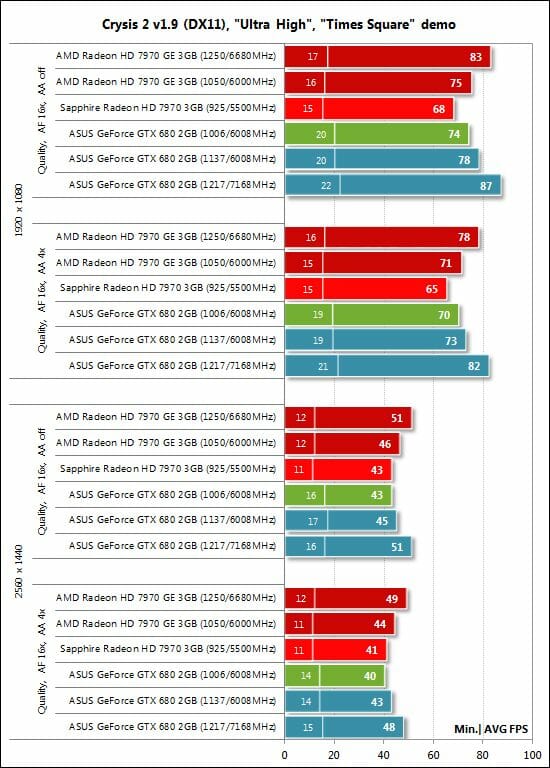
The Radeon HD 7970 used to be comparable to the GeForce GTX 680 in Crysis 2, so its GHz Edition wins the test, even though by a small margin. The top-end cards from AMD and Nvidia deliver the same performance here when overclocked.
Hard Reset Demo
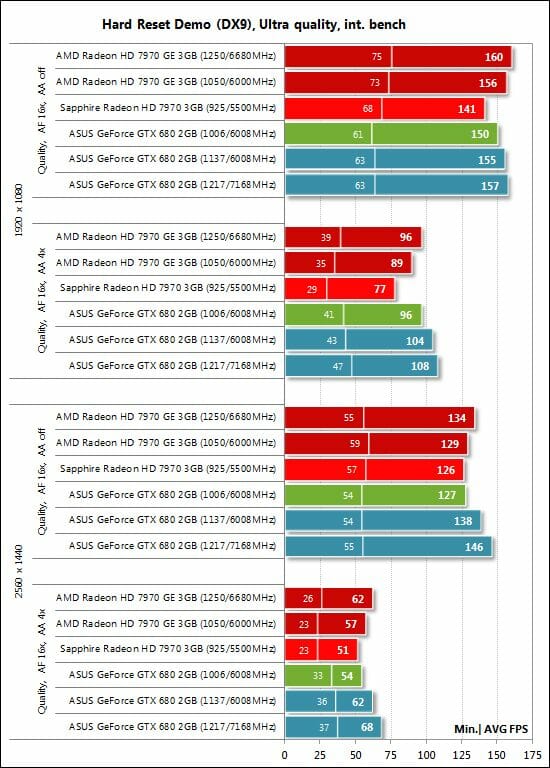
The Radeon HD 7970 GHz Edition is up to 16% faster than the regular Radeon HD 7970 and also beats the GeForce GTX 680 along the way. The latter accelerates more in Hard Reset when overclocked, beating the overclocked HD 7970 GHz Edition.
Batman: Arkham City
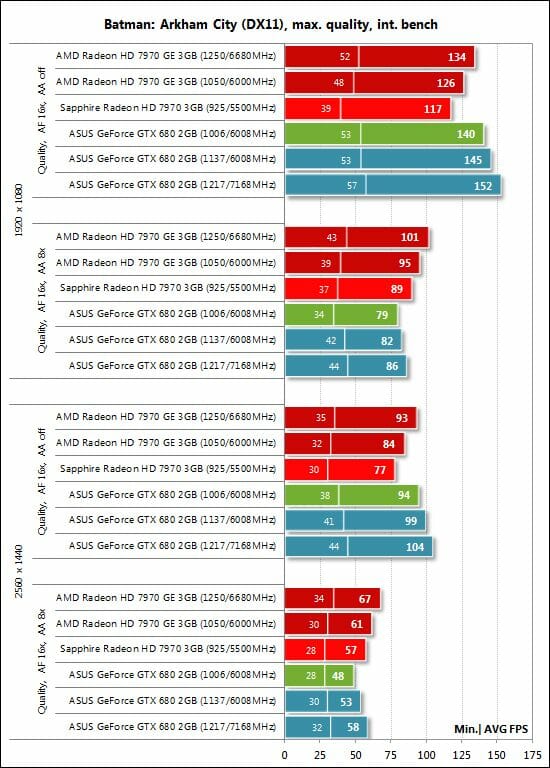
The GeForce GTX 680 is faster in Batman: Arkham City when we don’t use antialiasing. But as soon as we enable 8x MSAA, the Radeon HD 7970 GHz Edition goes ahead, being 7 to 9% faster than the ordinary HD 7970.
Battlefield 3
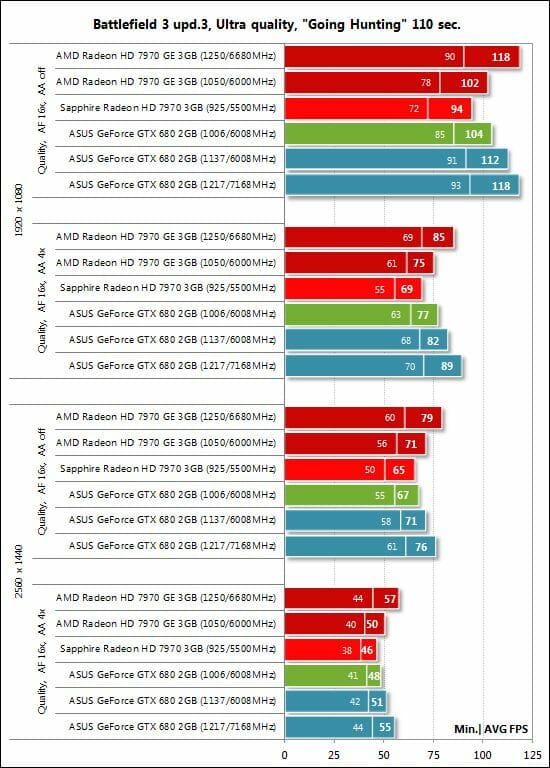
The increased clock rates of the new Radeon came in handy in Battlefield 3. The HD 7970 GHz Edition is as fast as the GeForce GTX 680 and even faster with antialiasing.
DiRT Showdown
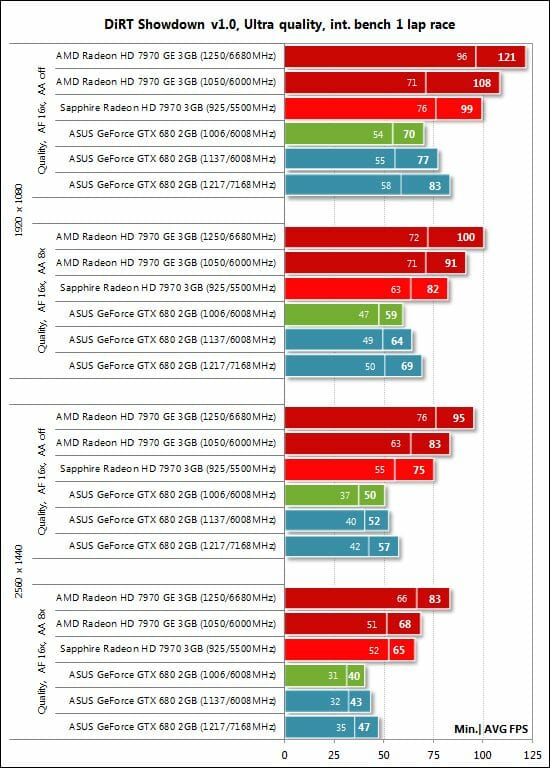
Nvidia GPUs are less efficient in this game whereas the AMD-based solutions deliver high performance.
Sniper Elite V2 Benchmark
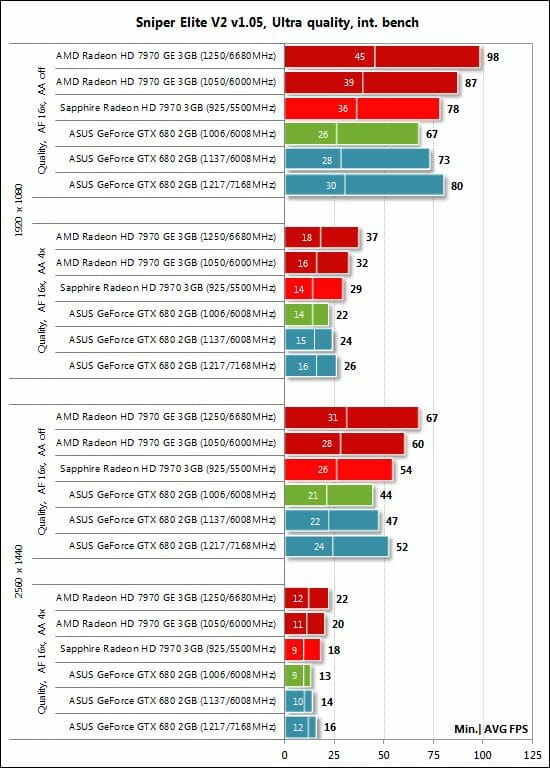
Like in the previous test, the Radeon HD 7970 GHz Edition enjoys a huge advantage over the GeForce GTX 680 – up to 54%!
Performance Summary
The first pair of summary diagrams compares the AMD Radeon HD 7970 GHz Edition (at 1050/6000 MHz) with the ordinary Radeon HD 7970 (925/5500 MHz).
The 13.5% higher GPU clock rate and 9.1% higher memory clock rate make the Radeon HD 7970 GHz Edition faster by 9.3 to 9.6% at 1920×1080 and by 9.9 to 10% at 2560×1440. The largest advantage can be observed in Aliens vs. Predator (2010) and Lost Planet 2. The advantage of the GHz Edition card is the smallest in Metro 2033: The Last Refuge.
Now let’s see the AMD Radeon HD 7970 GHz Edition 3GB compete against the GeForce GTX 680 2GB at their default clock rates.
The GeForce GTX 680 is still faster in the semi-synthetic benchmarks, in Lost Planet 2 and (at certain settings) in Just Cause 2, Hard Reset, Batman: Arkham City and Battlefield 3. The new AMD Radeon HD 7970 GHz Edition wins the rest of the tests, enjoying a large advantage in such games as Aliens vs. Predator (2010), Sid Meier’s Civilization V, Total War: Shogun 2, DiRT Showdown and Sniper Elite V2. Well, we shouldn’t forget that the performance of a graphics card depends on the particular game and its rendering engine. For example, the GeForce GTX 680 would be faster in StarCraft II: Wings of Liberty and Tom Clancy’s H.A.W.X. 2 but we’ve excluded these games from our list because the former is too CPU-dependent and the latter, too old.
And finally, let’s compare the AMD Radeon HD 7970 GHz Edition overclocked to 1250/6680 MHz with the ASUS GeForce GTX 680 TOP overclocked to 1217/7168 MHz.
The picture is overall the same, yet the GeForce GTX 680 has improved its position somewhat thanks to better overclocking (in percentage).
Conclusion
It wouldn’t be correct to claim that the AMD Radeon HD 7970 GHz Edition is the fastest single-GPU graphics card available today because our tests do not show it to be overwhelmingly better than the reference GeForce GTX 680. However, the increased clock rates make the new card 10% faster than the previous top-end solution from AMD, which really makes a difference in some games.
Besides, the release of the GHz Edition graphics accelerator ended up being not as exciting as we would expect it to be, just because there are currently a dozen or more Radeon HD 7970s cards with overclocked frequencies available in the market right now, some of which even have higher clock rates than the reference GHz Edition. That’s why the new card cannot really surprise us with its performance. Overclockers might have expected it to bring about a new stepping of the Tahiti XT chip with lower voltage and higher overclocking potential, but we couldn’t find any of that during our experiments. Hopefully, off-the-shelf samples of the new card will be more overclocker-friendly.